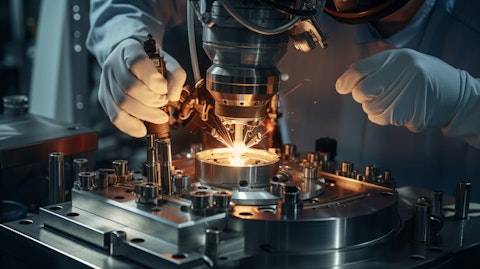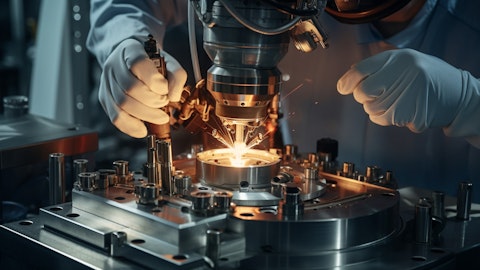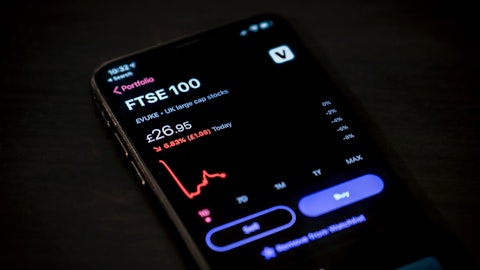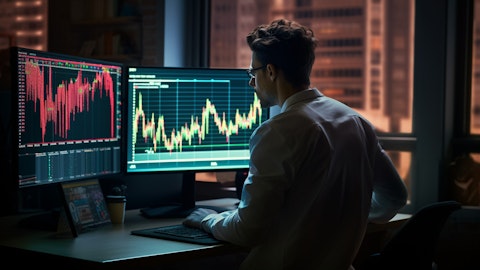Cabot Corporation (NYSE:CBT) Q1 2024 Earnings Call Transcript February 6, 2024
Cabot Corporation isn’t one of the 30 most popular stocks among hedge funds at the end of the third quarter (see the details here).
Operator: Good day, and thank you for standing by. Welcome to Cabot’s First Quarter 2024 Earnings Conference Call. At this time, all participants are in a listen-only mode. After the speakers’ presentation, there will be a question-and-answer session. [Operator Instructions] Please be advised that today’s conference is being recorded. I would now like to hand the conference over to your speaker today, Steve Delahunt, Vice President, Treasurer and Investor Relations. Please go ahead, sir.
Steve Delahunt: Thanks, Norma. Good morning. I would like to welcome you to the Cabot Corporation earnings teleconference. With me today are Sean Keohane, CEO and President; and Erica McLaughlin, Executive Vice President and CFO. Last night, we released results for our first quarter of fiscal year 2024, copies of which are posted in the Investor Relations section of our website. The slide deck that accompanies this call is also available on the Investor Relations portion of our website and will be available in conjunction with the replay of the call. During this conference call, we will make forward-looking statements about our expected future operational and financial performance. Each forward-looking statement is subject to risks and uncertainties that could cause actual results to differ materially from those projected in such statements.
Additional information regarding these factors appears in the press release we issued last night and in our 10-K for the fiscal year ended September 30, 2023, and in subsequent filings we make with the SEC, all of which are also available on the company’s website. In order to provide greater transparency regarding our operating performance, we refer to certain non-GAAP financial measures that involve adjustments to GAAP results. The non-GAAP financial measures referenced on this call are reconciled to the most directly comparable GAAP financial measure in a table at the end of our earnings release issued last night and available in the Investors section of our website. I will now turn the call over to Sean, who will discuss the first quarter highlights, followed by an update on our execution against our strategy and then discuss the company’s recent cash flow performance.
Erica will review the first quarter financial highlights and the business segment results. Following this, Sean will provide a strategic summary and closing comments and open the floor to questions. Sean?
Sean Keohane: Thank you, Steve, and good morning, ladies and gentlemen, and welcome to our call today. I am pleased with our first quarter results, which were aligned with our expectations and reflected strong year-over-year growth. We delivered adjusted earnings per share of $1.56, which is up 59% as compared to the same period in the prior year, setting us off to a strong start to fiscal year 2024. I would like to thank our entire global Cabot team for their resilience and commitment to execution as we navigate these dynamic times. EBIT in Reinforcement Materials was up 37% year-over-year, demonstrating the structural improvements, we have made in recent years to the business and a structurally tight supply/demand balance in the mature regions.
We also concluded our customer agreements with strong pricing and mix improvements in all regions that total an annualized increase year-over-year of $75 million. Net of inflationary and other cost increases, we expect the pricing and product mix benefits to equate to an EBIT increase of approximately $15 million per quarter for the remaining three quarters of fiscal year 2024 as compared to the same quarters of fiscal 2023. These results reflect the favorable supply and demand outlook and Cabot’s value proposition of supplier reliability, quality, and sustainability leadership. EBIT in Performance Chemicals was up 17% compared to the first quarter of fiscal 2023, as demand in the segment appears to have generally stablized and the effects of de-stocking have diminished.
While we did see some signs of pickup in our automotive applications, demand in other key end markets for this segment remained consistent with the September quarter. Cash flow was strong in the quarter, which supported the return of $55 million to shareholders through a combination of share repurchases and dividends. And finally, we continue to be recognized for our leadership in sustainability. For the fifth consecutive year, we were named to Newsweek’s list of Most Responsible Companies. This distinction recognizes our strong performance in the areas of environmental, social and governance, and we are very proud of this recognition. With the company off to a strong start to our fiscal 2024 and a track record of disciplined execution, I am confident in our ability to deliver continued earnings and cash flow growth consistent with our Creating for Tomorrow strategy.
As we discussed last quarter, the EBIT performance in the Reinforcement Materials segment has increased dramatically over the past eight years, supported by the long-term resilience of the replacement tire market and an increasingly tight supply/demand balance in the mature regions. The industry is also facing stricter environmental regulations that require producers to make significant abatement investments to ensure reliable and sustainable supply to our customers. These investments raise the barriers to entry for additional capacity, roughly doubling the cost of new capacity. Furthermore, I believe we have structurally improved our performance through a commitment to commercial and operational excellence across the company. Over the past decade, we have invested in the marketing and sales capabilities of our team and relentlessly pursued continuous improvement across our manufacturing network to drive excellence in yields, OEE, and energy recovery.
As a result of these factors, I believe the outlook for this business remains strong. Our expectation is that we will see continued earnings growth driven by enhanced pricing and product mix, volumes that move in line with growth of passenger and freight miles driven, differentiated capacity adds in high-growth markets such as Indonesia, continued efficiency benefits from yield, OEE, and energy recovery, and finally, innovation contributions through our EVOLVE Sustainable Solutions and E2C technology platforms. In our fiscal 2023, Performance Chemicals’ results were impacted by significant de-stocking, but we have seen these impacts diminish in our most recent quarters. While we do not expect the same impact to our sales volumes from destocking in fiscal 2024, we have not yet seen signs that some of our key end markets such as building and construction, infrastructure, and consumer durables are moving back to prior levels.
This segment is comprised of a core group of businesses with a GDP-plus growth outlook and strong earnings potential. In addition, we are building out our strategic positions in battery materials and inkjet, two growth vectors that offer compelling long-term growth and where we believe we have a strong right to win. In battery materials, we expect the market to grow between 20% and 30% over time and we are well positioned with the leading global EV battery makers, particularly as they expand in the western economies. In inkjet, we are winning share with printer OEMs that are serving the packaging market as it transitions from traditional analog printing to digital. EBIT in this segment is expected to grow north of 20% per year and we are well positioned to capture this growth.
We remain confident that these businesses can be material contributors to Cabot’s earnings profile in the coming years. With this portfolio of businesses, we have been delivering strong earnings growth over time. When we met in December of 2021 at our Investor Day, we had just completed fiscal year 2021 and had achieved adjusted earnings per share of $5.02, which represented a compound annual growth rate of 12% from 2015. We set a three-year target at that Investor Day with the expectation to grow adjusted earnings per share between 8% and 12% by 2024. Our current outlook for fiscal 2024 puts us in this band and would reflect a 9% CAGR at the midpoint of our guidance range. While the macroeconomic environment has weakened since Investor Day in 2021, we continue to manage the businesses dynamically and execute to deliver on our commitments.

I remain confident in the resilience and strength of our portfolio and in achieving the Corporate Investor Day target for adjusted earnings per share growth. In addition to strong growth in adjusted earnings per share, the Cabot portfolio has robust cash flow characteristics. On a trailing 12-month basis, our strong execution has resulted in operating cash flow of $648 million. Free cash flow yield over that same time period was 8.3%, which puts us in the top quartile of the S&P 1500 Chemicals Index. Our cash generation power allows us to pursue a balanced capital allocation strategy focused on funding strategic investments to deliver long-term earnings growth and returning cash to shareholders while maintaining a strong investment-grade balance sheet.
We have maintained a continuous and growing dividend since 1968 and that commitment remains a core part of our capital allocation priorities. Over the last 12 months, we paid $89 million in dividends, including an 8% increase in May, reflecting our confidence in the long-term cash flow outlook for the company. We would expect to continue to raise the dividend over time as our earnings grow. We also repurchased 114 million of shares over the last 12 months. We plan to offset dilution every year and will be opportunistic with additional purchases based on our outlook for cash flow and the timing of growth investment opportunities. The dividends paid and shares repurchased totaled $203 million in the past 12 months, equating to a total payout ratio of 61%.
We also set a corporate discretionary free cash flow target at our December ’21 Investor Day, which was to generate in excess of $1 billion of discretionary free cash flow over three years. We are also on track to achieve this target in fiscal 2024. The strength of our cash flow generation and disciplined capital allocation are fundamental to the strong Cabot investment thesis and are a priority for this management team. I will now turn it over to Erica to discuss the segment and financial performance in the quarter. Erica?
Erica McLaughlin: Thanks, Sean. I’ll start with discussing results for the company and then review the segment results. Adjusted EPS for the first quarter of fiscal 2024 was $1.56 compared to $0.98 in the first quarter of fiscal 2023, with growth coming from both the Reinforcement Materials and Performance Chemicals segments. Cash flow from operations was strong at $105 million in the quarter, which included a working capital increase of $46 million. Discretionary free cash flow was $118 million in the quarter. We ended the quarter with a cash balance of $244 million and our liquidity position remained strong at approximately $1.2 billion. Capital expenditures for the first quarter of fiscal 2024 were $54 million, and we continue to expect $250 million to $275 million of capital spending for the fiscal year.
Additional uses of cash during the first quarter were $22 million for dividends and $33 million for share repurchases. Our debt balance was $1.3 billion and our net debt to EBITDA was 1.5 times. The operating tax rate for the first quarter of fiscal 2024 was 28% and we anticipate our operating tax rate for fiscal 2024 will be in the range of 28% to 30%. One additional item to note is the benefits seen in the general unallocated income. As we discussed last quarter, this line item of general unallocated income and expense includes currency exposures related to our net asset positions, mainly in South American currencies and investment income we earn in that region, as well as the interest income on our global cash balances. During the quarter, we experienced a foreign currency loss due to a government-imposed devaluation in Argentina.
On December 13, the Argentinian government devalued the currency from ARS365 per dollar to more than ARS800, resulting in a foreign currency loss of $33 million on that day. We treated this as a certain item consistent with how we treated the Argentina government devaluation in August and how we have treated similar government-imposed devaluations in other countries, most recently being Venezuela. The market depreciation of the Argentinian peso throughout the rest of the quarter, which was an expense of $7 million, is included in operating results, as only the impact on the day of the government devaluation was treated as a certain item. During the quarter, interest and investment income in Argentina outpaced the foreign currency losses in operating results and was the driver of general unallocated income of $13 million in the first quarter.
While currency movements are quite difficult to predict, as we look ahead, we are expecting in the range of $7 million to $9 million per quarter for general unallocated income, driven by interest and investment income and the net foreign currency impacts on our cash balances. Now, moving to Reinforcement Materials. During the first quarter, EBIT for Reinforcement Materials was $129 million, which was an increase of $35 million as compared to the same period in the prior year. The increase was driven by higher pricing and product mix in our 2023 calendar year customer agreements and higher volumes. Globally, volumes were up 2% in the first quarter as compared to the same period of the prior year due to 11% growth in Europe and 7% in Asia as demand in those regions improved.
Looking to the second quarter of fiscal 2024, we expect the Reinforcement Materials EBIT to improve sequentially due to the outcome of our calendar year 2024 customer agreements and modestly higher sequential volumes. Now, turning to Performance Chemicals, EBIT increased by $5 million in the first fiscal quarter as compared to the same period of fiscal 2023. The increase was driven by higher volumes in the specialty carbons, specialty compounds, and fumed metal oxides product lines, as the destocking we experienced in 2023 was not a significant factor in the first quarter of fiscal 2024. Looking ahead to the second quarter of fiscal 2024, we expect a sequential increase in volumes, driven by seasonality impacts, more than offset by higher costs sequentially, including $4 million of higher costs associated with maintenance activities and the impact of reducing inventory levels.
I will now turn the call back over to Sean to discuss the fiscal year outlook. Sean?
Sean Keohane: Thanks, Erica. Moving to our 2024 outlook, we feel very good about the first quarter results and the remainder of the year. We are reaffirming our outlook for adjusted earnings per share in the range of $6.30 to $6.80, which is up 22% at the midpoint year-over-year. In terms of the assumptions that underpin our outlook, the key drivers of earnings growth continue to develop as we expected. We had a strong outcome to our calendar year 2024 reinforcement materials customer agreements, reflecting the structurally tight supply/demand dynamics and the importance of regional supply security, quality consistency, and sustainability leadership to our customers. The improved pricing and mix from our calendar year 2024 agreements will drive margin improvement in fiscal 2024.
We continue to believe that the Q4 2023 volume run rate is a good basis for segment volumes in fiscal 2024, which would imply low single-digit percentage growth compared to fiscal year 2023. These factors will drive our expectation for another year of strong EBIT growth in the Reinforcement Materials segment. The Performance chemical segment is still expected to be impacted by weakness in certain end markets, with volumes on average expected to be similar to the fourth quarter of fiscal 2023. Regarding margins for the segment, we continue to expect relatively consistent margins to the Q4 exit rate. Cash generation is expected to remain strong and we intend to return a robust amount of cash to shareholders through dividends and share repurchases.
Overall, I’m very pleased with how the company is positioned today, and I’m confident in the outlook for the year. Thank you very much for joining us today, and I’ll now turn the call over for our Q&A session.
See also Top 20 Most Innovative Economies in Asia and 15 Highest Quality Bed Sheets of 2024.
Q&A Session
Follow Cabot Corp (NYSE:CBT)
Follow Cabot Corp (NYSE:CBT)
Operator: Thank you. [Operator Instructions] Our first question comes from the line of David Begleiter with Deutsche Bank. Your line is now open.
David Huang: Hi, it’s David Huang here for Dave. I guess first on China, can you talk about your outlook for the key segments specific to China and what type of volume outlook is embedded in the full-year guidance?
Sean Keohane: Sure. Hi, David. So maybe an update on China, and I’ll sort of pull the lens back a bit in terms of what we’re seeing there. I would say, the Chinese economy appears to have stabilized, albeit at a lower level of growth than we’ve seen historically. And it is showing some signs of marginal improvement in the recent months. We’ve definitely seen some pockets of stronger demand in certain sectors, notably in tire, driven by replacement tire exports and the automotive OE sector. And the growth, I think, in the replacement tire exports is likely a sign that supply chains are destocked in the West and there’s a need for more tire inventory. But the latest economic indicators released in Q4, in the calendar Q4 of ’23 and for the full year calendar ’24 were largely consistent with market expectations.
And so, I think we’re seeing some stability here. The housing market, which accounts for about 25% of China’s overall economy, is still quite weak, and we believe it’ll take some time to replace this demand driver. But the government is trying to stimulate consumer confidence and we’re seeing actions on that front. I just came back from a two-week trip to China, and I think there’s a pretty consistent narrative that the government has stimulus plans around their so-called three major projects, which are building out affordable housing, urban renovation, and what they’re calling dual-use infrastructure. So things like 5G and EV charging and renewable energy and power distribution, these types of forms of infrastructure. So, I think these efforts, if we see them materialize, will definitely drive demand for chemicals, but we’ll have to see how things develop coming out of Chinese New Year.
I think the next few months will be important and we’ll be monitoring the situation closely and we’ll continue to actively manage our business there in this dynamic situation. So, overall, I think growth expectations would probably be kind of in line with the latest macroeconomic indicators out of China, which sort of has GDP growth in the 4% to 5% range, something like in that zone.
David Huang: Okay. Got it. And then on battery materials, do you still expect EBITDA to be up in ’24, given all the incremental challenges, I guess, in some parts of the EV battery chain?
Sean Keohane: Yeah, definitely, the sentiment across the EV and battery chain is somewhat depressed right now. We would expect EBITDA to grow in fiscal year ’24 based on continued year-over-year volume growth and a better product mix in China as we optimize our participation and drive a higher penetration of our performance grades. Now, I think growth in fiscal ’24 is expected to be more second-half driven as OEMs and battery makers are expected to reduce what are pretty high inventory levels in this coming quarter, in the March quarter. So that’s definitely a factor in China today. Outside of China, we’re expecting volumes to be higher than fiscal year ’23, though, again, the ramp is somewhat difficult to project here, but overall, we’d expect to grow profitability in fiscal ’24, I would say, roughly in line with battery production growth. That’s probably the best way to think about it.
David Huang: Okay. Thank you.
Operator: Thank you. One moment for our next question, please. Our next question comes from the line of Laurence Alexander from Jefferies. Your line is now open.
Laurence Alexander: Good morning. In Reinforcement Materials, how much of your volumes are now covered by multi-year contracts?
Sean Keohane: On multi-year contracts, very little, Laurence. They’re largely all one-year agreements.
Laurence Alexander: Okay.
Sean Keohane: In fiscal ’24, we had a residual of two-year agreements from last year, so we’ll have the second year in 2024. And then the negotiations that we had this year were one-year agreements, and that was really reflecting our view on outlook. I would say multi-year discussions were a more minor part of the conversation. And given the market environment we were negotiating this year, we were not seeking multi-year deals.
Laurence Alexander: And how much can you debottleneck capacity across your system each year?
Sean Keohane: Yeah. So, the way that we think about capacity, Laurence, are really two levers. One is continuing to drive what we call OEE, overall equipment effectiveness. And so this is really driving up the uptime in the assets, as well as the throughput rates and minimizing off quality. Those three factors calculate to what’s called OEE. And, of course, that is the first priority for us because that is the most capital-efficient way to grow capacity. And over a period of time here, we’ve substantially improved the OEEs. And so, I think you can expect to get a 1 point or 2 points of OEE each year, that kind of an increase. And then, the second lever is what we call capital-efficient debottlenecks. And so this would be where there is relatively minor capital required to debottleneck a particular unit operation in the plant in order to unlock some additional capacity.
And I would say every carbon black plant has an option set of debottlenecks that can be done, some more capital efficient than others, but these are generally very capital-efficient ways. So, if you then take those two levers and match them up against what is a low single-digit growth rate from a demand standpoint, we feel confident that we’ve got growth runway here for multiple years.
Laurence Alexander: And then, with the carbon elastomers projects, if you invested more, could you accelerate market adoption, or is it purely sort of customer considerations at this point?



